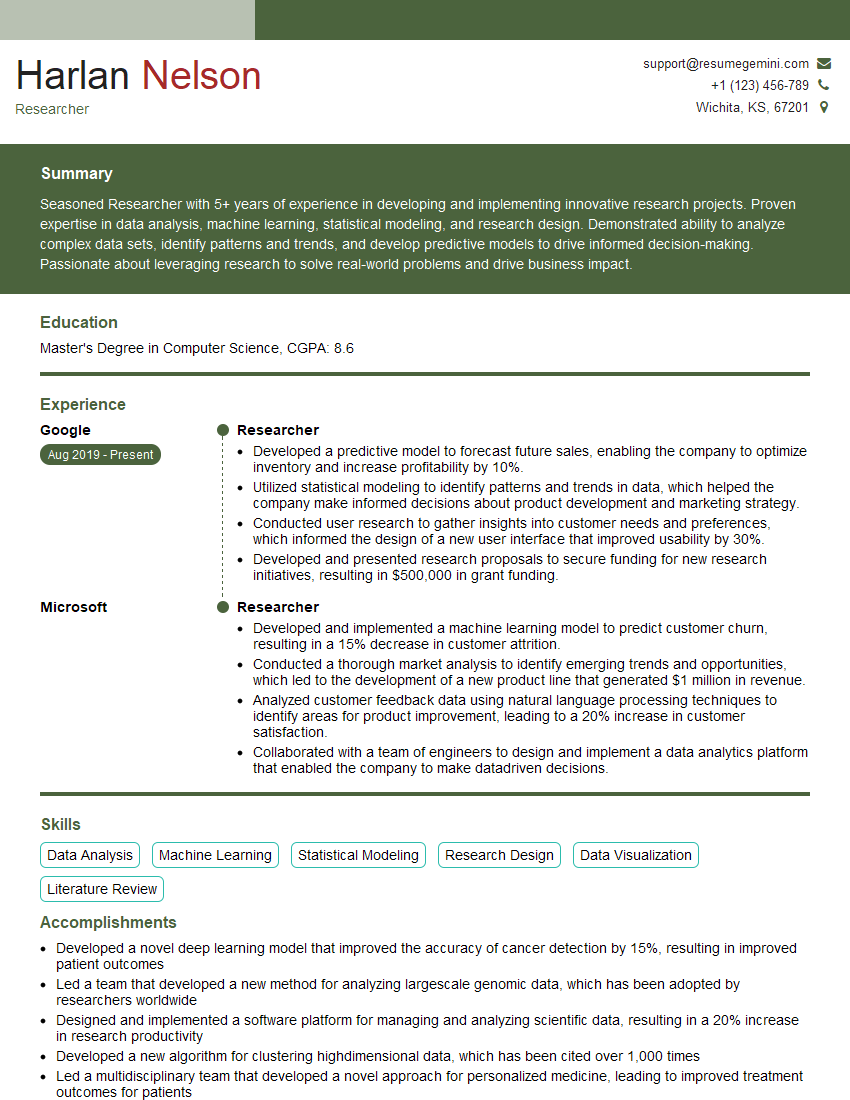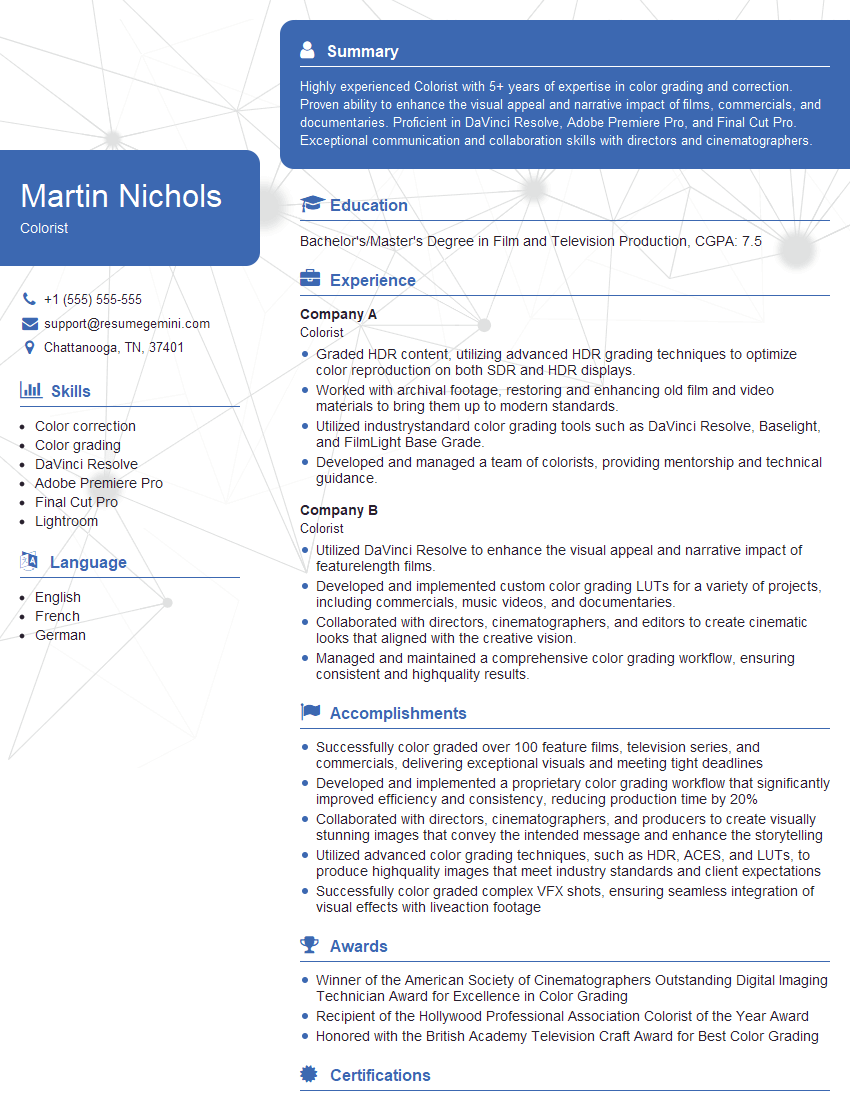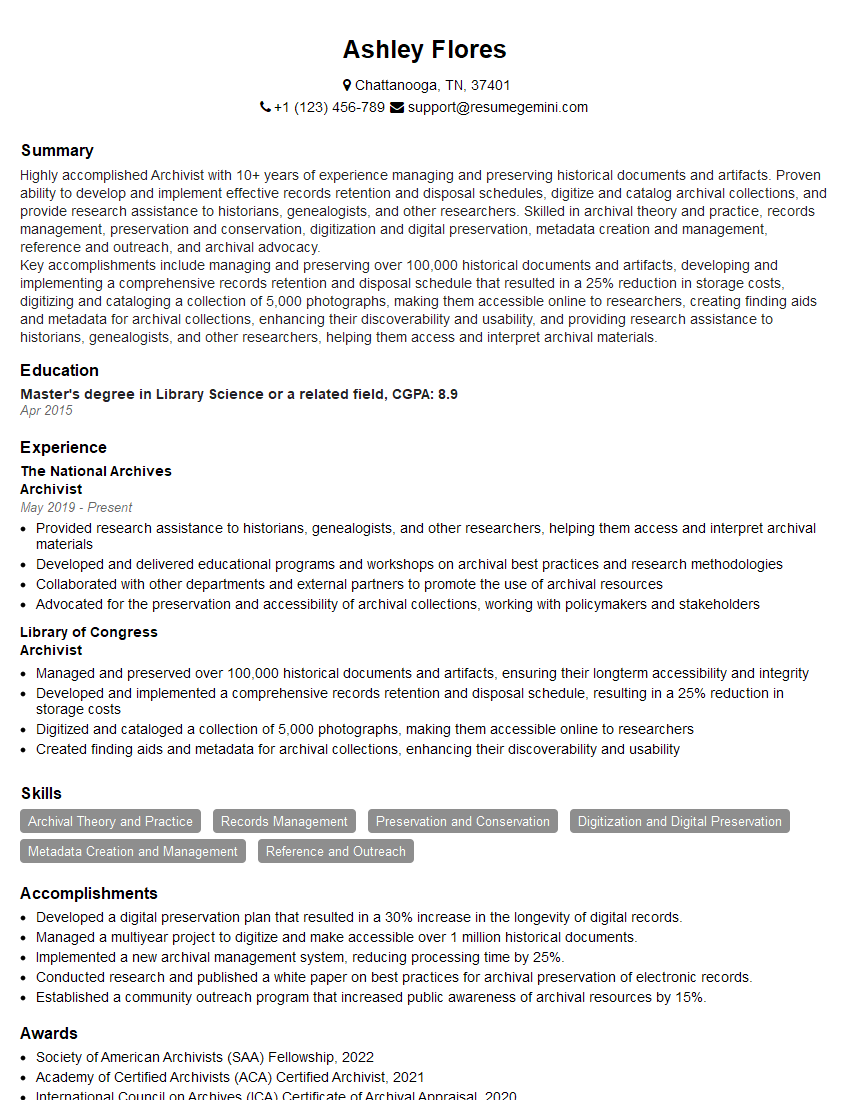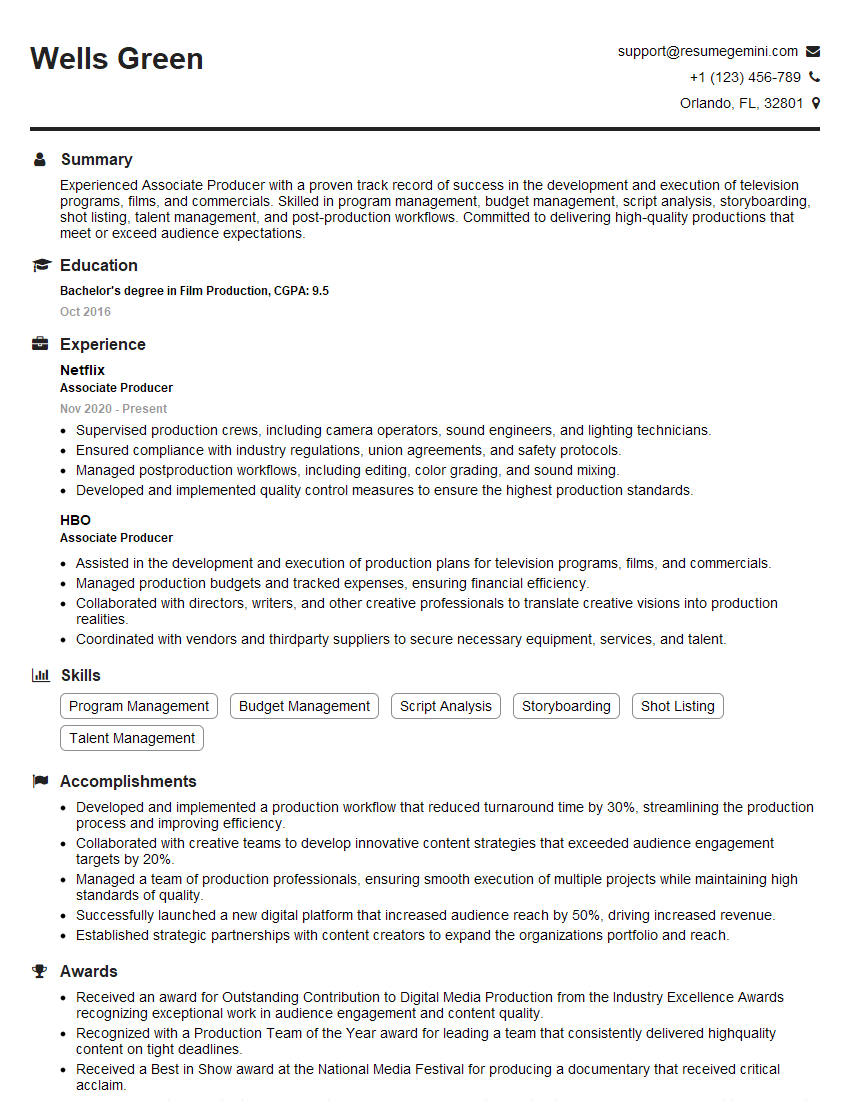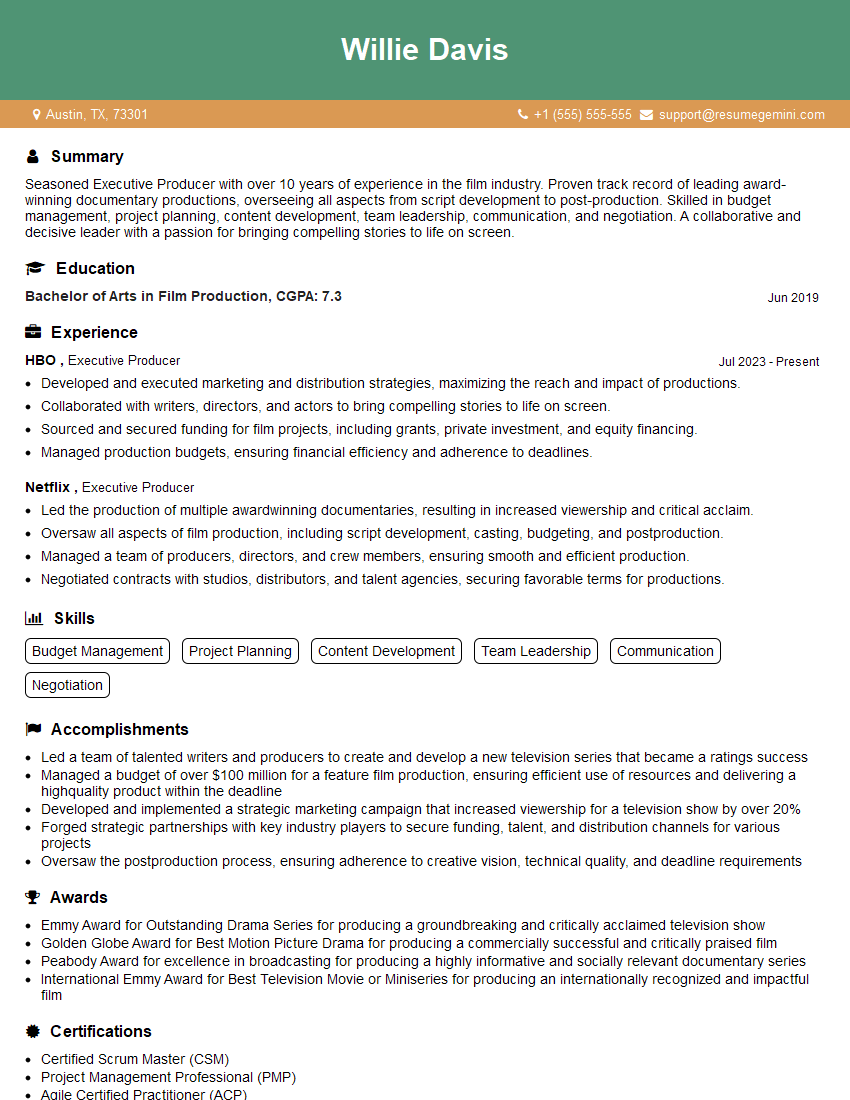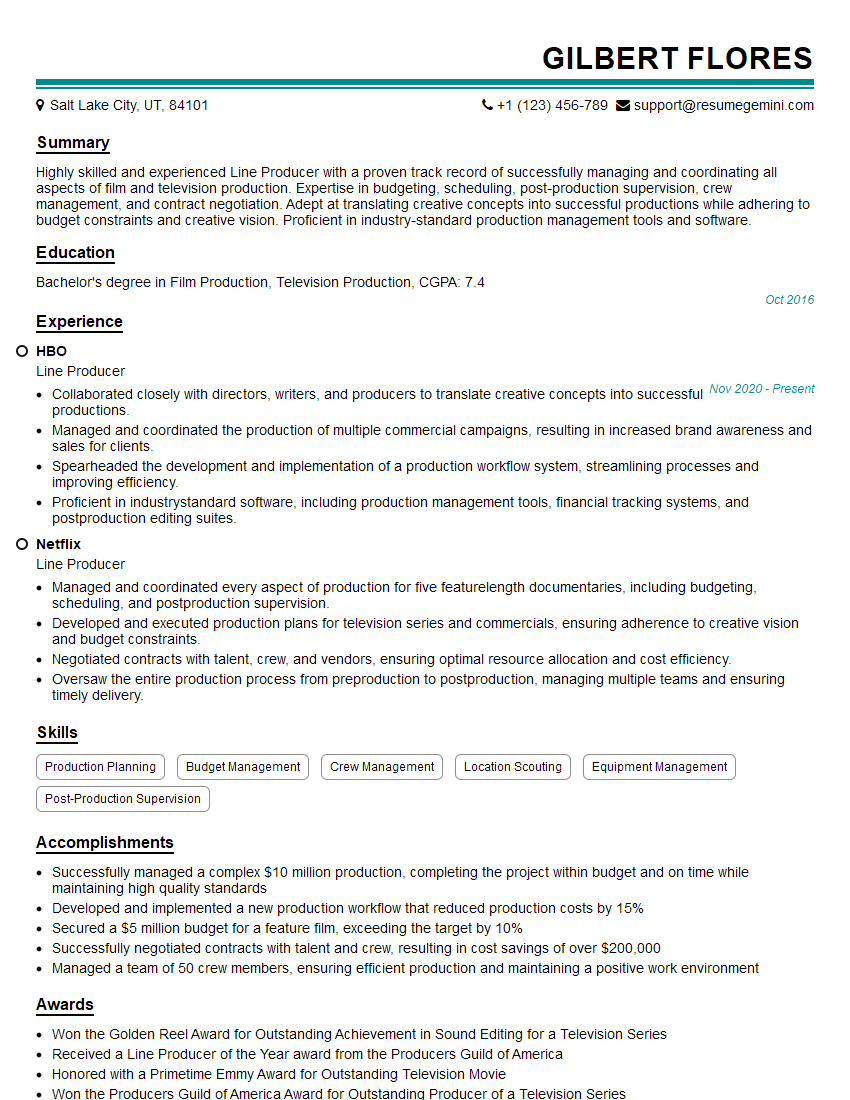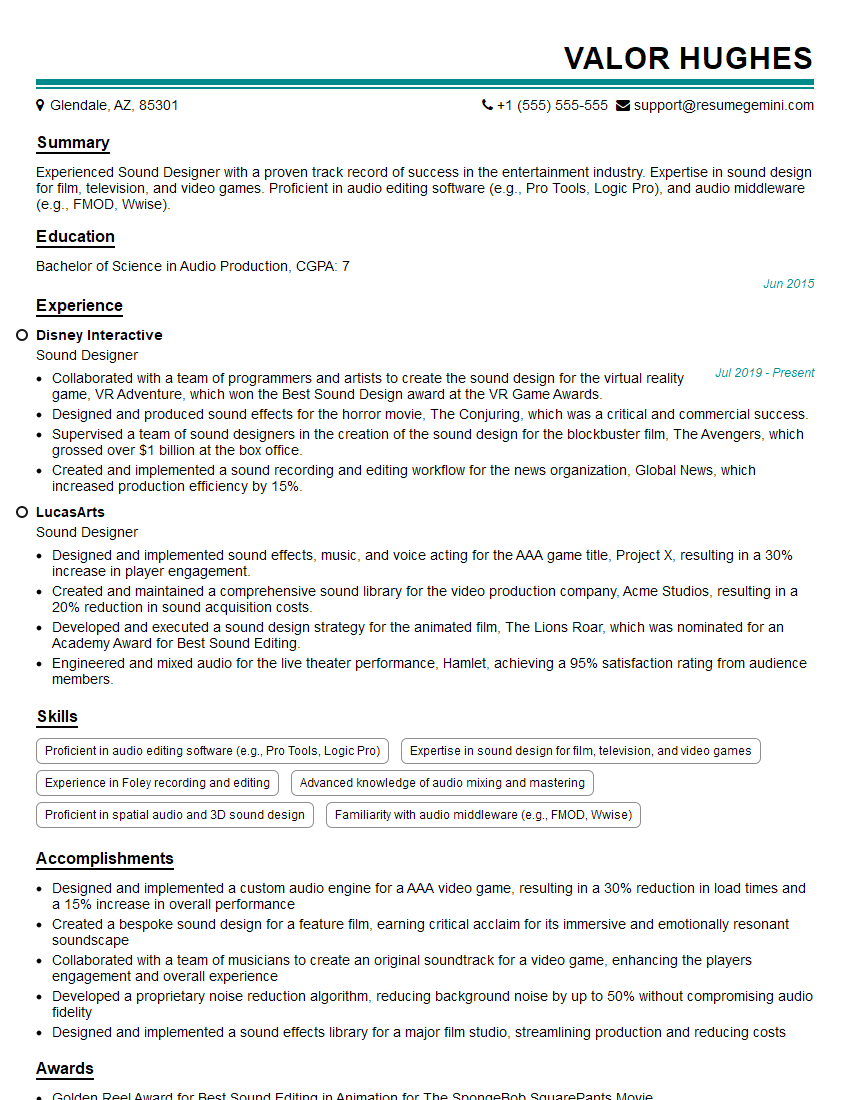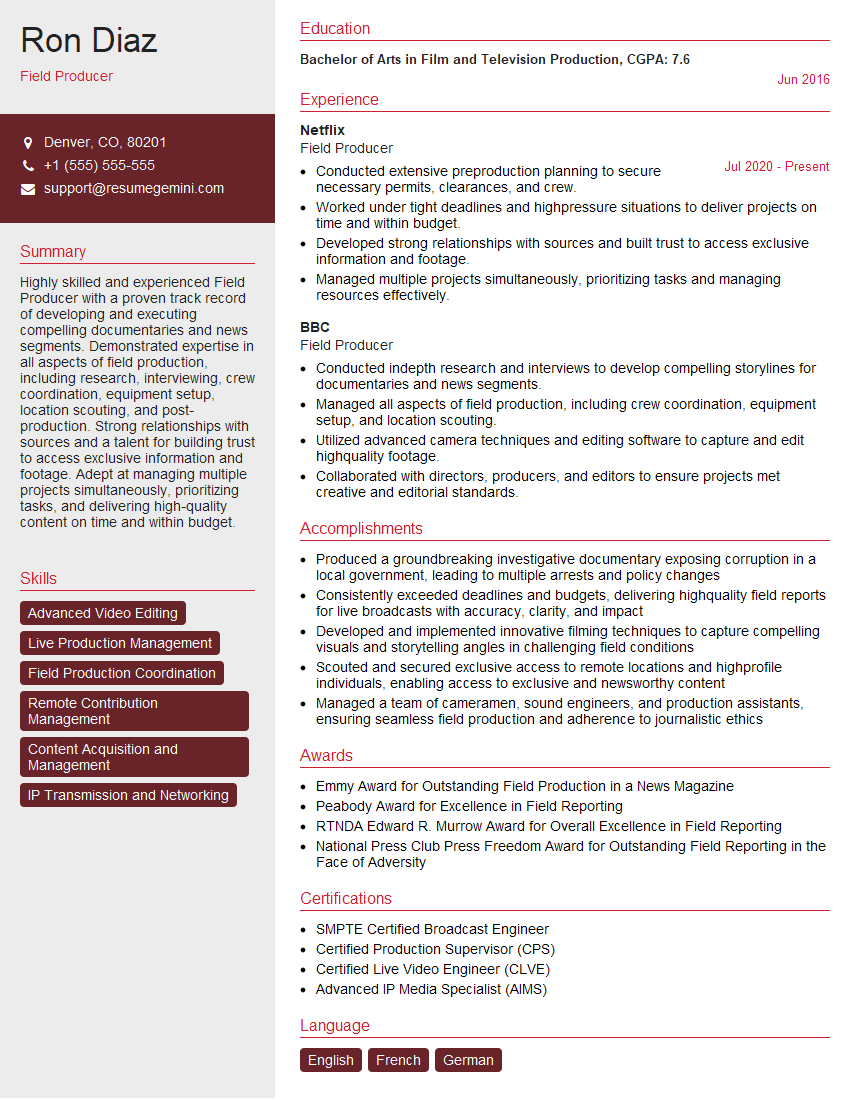The thought of an interview can be nerve-wracking, but the right preparation can make all the difference. Explore this comprehensive guide to Documentary Production interview questions and gain the confidence you need to showcase your abilities and secure the role.
Questions Asked in Documentary Production Interview
Q 1. Describe your experience with different documentary filmmaking styles (e.g., observational, expository, participatory).
My experience spans various documentary filmmaking styles, each offering unique storytelling approaches. Observational filmmaking, for example, involves minimal intervention, allowing events to unfold naturally. I’ve used this style in a project documenting the daily life of a remote village, capturing authentic moments without influencing the subjects’ behavior. The resulting film felt incredibly intimate and revealing. Conversely, expository documentaries utilize narration and voiceovers to present a clear argument or perspective. In a project on climate change, I employed this approach, weaving together expert interviews and compelling visuals to deliver a concise and informative message. Participatory filmmaking actively involves subjects in the creative process, fostering collaboration and ownership. I employed this method in a film about community activism, where participants helped shape the narrative and ensure accurate representation. Finally, reflexive documentary filmmaking acknowledges the filmmaker’s presence and impact on the subject matter, a self-aware approach that often yields insightful meta-commentary on the process of filmmaking itself.
Q 2. Explain your process for securing interview subjects and obtaining necessary permissions.
Securing interview subjects and obtaining permissions is crucial for ethical and legal compliance. My process starts with thorough research to identify key individuals. I then reach out with a personalized letter or email explaining the project’s goals and ensuring confidentiality. Transparency is key—I clearly outline how their participation will be used. I always obtain informed consent, providing them with a copy of the consent form and ensuring they understand their rights. This often involves multiple conversations to build trust and address any concerns. For sensitive topics, I might consult an ethics board. For filming in public spaces, I usually need no further permissions unless I’m using specific locations which require prior authorization. Obtaining property releases, model releases, and music licensing rights is standard procedure, ensuring proper clearance for all included elements.
Q 3. How do you handle ethical considerations in documentary filmmaking?
Ethical considerations are paramount in documentary filmmaking. My primary focus is to ensure the accuracy and fairness of representation. This involves avoiding misleading edits, presenting multiple perspectives where possible, and diligently fact-checking all information. I also prioritize the well-being of my subjects. I ensure they’re comfortable during filming, have the right to review footage related to them, and are not subjected to coercion or undue pressure. Anonymity or pseudonyms are used when necessary to protect individuals’ identities or avoid potential harm. I carefully consider potential impacts on the subjects and their communities, ensuring the film doesn’t inadvertently cause damage or exploitation. In cases of particularly sensitive material, I consult with ethics boards or relevant experts to ensure responsible handling.
Q 4. What software and equipment are you proficient in using for documentary production?
My expertise encompasses a wide range of software and equipment. I’m proficient in editing software such as Adobe Premiere Pro and Final Cut Pro, adept at color grading and visual effects. For sound, I use professional audio recorders such as the Zoom F6 and microphones suitable for various situations—boom mics, lavalier mics, and shotgun mics. For filming, I utilize professional cameras, including cinema cameras and DSLRs, depending on the project’s needs. I am familiar with various lenses and lighting equipment to manage light effectively. I also utilize cloud storage for collaborative projects and asset management.
Q 5. Outline your workflow for editing a documentary film.
My editing workflow is iterative and collaborative. It begins with ingesting footage and audio, followed by a rough cut where I assemble the sequence based on the narrative structure. This involves selecting the most impactful scenes and arranging them chronologically or thematically. Next is a fine cut, where I refine the pacing, transitions, and overall flow. This stage involves sound design, color correction, and adding music and graphics. The process is often interspersed with feedback from producers and other team members. After revisions, the film goes through a final color grade, sound mix, and QC process. Finally, it’s mastered for various distribution platforms.
Q 6. Describe your experience with sound recording and mixing in documentary production.
Sound is vital in documentary filmmaking; it sets the mood, enhances emotional impact, and ensures clarity. I prioritize capturing high-quality audio during filming. This means using appropriate microphones, properly positioning them, and monitoring sound levels. During post-production, I meticulously clean up audio, removing background noise and unwanted sounds. I meticulously work on sound design, using music, sound effects, and Foley to add atmosphere and enhance storytelling. The final sound mix must be balanced and seamless, ensuring clarity of dialogue and a rich soundscape that complements the visuals.
Q 7. How do you manage budgets and timelines in documentary projects?
Budgeting and scheduling are critical for successful documentary production. My approach involves creating a detailed budget outlining all anticipated costs—equipment rental, crew salaries, travel expenses, post-production services, and licensing fees. I create a realistic timeline that factors in each production stage—pre-production, filming, editing, and distribution. This timeline usually includes buffer periods to handle unexpected delays. Regular monitoring and adjustments are vital. I utilize project management software to track progress, manage resources, and maintain communication among the team. Effective communication with clients is also essential to manage expectations and resolve any issues.
Q 8. Explain your approach to storytelling in documentary filmmaking.
My approach to storytelling in documentary filmmaking centers around finding the human element within a larger narrative. I believe the most compelling documentaries don’t just present facts; they evoke emotions and connect with the audience on a personal level. I start by identifying a central theme or question that drives the film, and then I build the narrative around characters whose experiences illuminate that theme. I aim for a clear arc, with a beginning, middle, and end, even if the subject matter is complex. Think of it like crafting a compelling novel, but with real people and real events.
For instance, in my documentary about urban farming, I didn’t just focus on the statistics of food insecurity; instead, I followed the journey of several individuals involved in a community garden – their struggles, their triumphs, their motivations. This allowed the audience to connect emotionally with the issue and understand its impact on real lives. I use a combination of interviews, observational footage, and archival material to weave together a story that is both informative and engaging. The narrative structure is carefully planned, moving from introducing the core problem to exploring the complexities and concluding with a sense of resolution or a call to action.
Q 9. How do you ensure the accuracy and factual integrity of your documentary?
Ensuring accuracy and factual integrity is paramount in documentary filmmaking. My process begins long before filming even starts. It involves extensive research, fact-checking, and verifying information from multiple sources. I cross-reference information with academic studies, official records, and primary source materials whenever possible. Interviews are conducted with a critical eye, ensuring that the interviewees’ statements are supported by evidence and corroborated when necessary. I always strive to present multiple perspectives on an issue, avoiding bias and presenting information in a fair and balanced manner.
Moreover, I always clearly differentiate between fact and opinion. Any claims made in the documentary are clearly supported by evidence presented within the film. The editing process involves several layers of fact-checking and verification. I meticulously review all footage and ensure that the context and meaning are accurately represented. Finally, I involve experts and subject matter specialists in the review process for a final validation before the film is finalized.
Q 10. Describe your experience working with archival footage.
Working with archival footage is a crucial aspect of many documentaries, enriching the narrative and providing historical context. My approach begins with extensive research to locate relevant material, often sifting through vast archives, libraries, and private collections. Once I’ve identified potential footage, I assess its quality, considering factors such as resolution, condition, and relevance to the narrative. The process involves careful cleaning and restoration, often requiring specialized software and techniques to enhance the visual quality. I carefully consider the provenance of the footage and its potential biases, ensuring that it’s used responsibly and ethically within the broader context of the documentary.
For example, in a documentary about the civil rights movement, I unearthed home movies from a participant’s personal archive. These provided intimate glimpses into events often only documented in official records. However, it was crucial to balance these personal perspectives with other sources to provide a comprehensive, nuanced picture. This involved careful contextualization and acknowledgement of any limitations of the archival material.
Q 11. How do you incorporate graphics and visual effects in your documentaries?
Graphics and visual effects in documentaries are used judiciously to enhance understanding and engagement, never to manipulate or misrepresent the truth. My approach prioritizes clarity and accuracy. I use graphics to present complex data in an easily digestible format—for instance, charts and graphs to illustrate statistical trends or maps to show geographical locations. Visual effects are primarily employed for restoration of archival footage, subtle transitions, or to enhance the viewer’s experience, perhaps highlighting key moments without distracting from the main narrative.
It’s important to maintain a balance; excessive use can detract from the documentary’s authenticity and credibility. The goal is to support the storytelling, not to overshadow it. For instance, a brief animated sequence might help illustrate a complex scientific process, while subtle color correction might improve the visual quality of older footage without altering its historical integrity. The style should always remain consistent with the overall tone and aesthetic of the documentary.
Q 12. What is your experience with color grading and correction for documentaries?
Color grading and correction are essential for establishing the overall look and feel of a documentary, and for ensuring consistency across different shots and footage sources. My approach involves a delicate balance between enhancing the visual quality and maintaining realism. I aim for a natural and consistent look, avoiding overly stylized or artificial effects, unless they serve a specific narrative purpose. Color correction is crucial to address lighting inconsistencies, variations between different camera shots, and the restoration of archival footage. Color grading then helps to establish the overall mood and atmosphere—perhaps a warmer palette for a nostalgic piece, or a cooler tone for a more serious subject.
The process involves careful analysis of the footage and collaboration with a skilled colorist. We carefully consider the historical context and the emotional impact that color can evoke. For instance, a documentary about the Great Depression might employ desaturated colors to reflect the era’s hardships, while a nature documentary might aim for vibrant, realistic colors to showcase the beauty of the natural world. The key is to ensure the color palette supports the story, enhancing the viewer’s experience without compromising the integrity of the footage.
Q 13. Explain your approach to music selection and sound design for documentaries.
Music and sound design are integral to a documentary’s emotional impact and storytelling. My approach to music selection is deeply intertwined with the narrative arc. I look for music that complements the mood and tone of each scene, subtly enhancing the emotional experience without overwhelming the visual content. I often work with composers to create original scores tailored specifically to the film, which allows for a seamless integration with the visuals. The music should feel organic to the story rather than a mere backdrop.
Sound design is equally important. It includes ambient sounds, dialogue clarity, sound effects, and foley work. These elements contribute to the film’s realism and immersive quality. The goal is to create an aural landscape that enhances the narrative and transports the viewer into the world of the documentary. For example, in a documentary about a bustling city, the sound design might include the constant hum of traffic, the chatter of crowds, and the distant sirens. Careful attention to these details helps create a sense of place and atmosphere.
Q 14. How do you handle unexpected challenges during filming?
Unexpected challenges are inevitable in documentary filmmaking. My approach to handling them relies on adaptability, resourcefulness, and a strong team. Having contingency plans is essential; this includes having backup equipment, alternative interview subjects, and a flexible shooting schedule. When unexpected issues arise, I prioritize problem-solving and collaboration. Open communication with the team is crucial; we brainstorm solutions together, assessing the impact on the overall narrative and adjusting accordingly. Maintaining a calm and focused approach is vital, as is the ability to pivot and adapt to changing circumstances.
For instance, a key interviewee might become unavailable at the last minute. This requires quick thinking, potentially finding a substitute or re-evaluating the interview strategy. Or, weather conditions might unexpectedly disrupt outdoor filming. This necessitates a flexible approach, perhaps rescheduling or finding alternative locations. The ability to remain calm, think creatively, and adapt quickly are indispensable skills in documentary filmmaking.
Q 15. Describe your experience collaborating with a production team.
Collaboration is the lifeblood of documentary filmmaking. My experience spans working with teams ranging from small, independent crews to larger productions with multiple departments. I’ve found success hinges on clear communication, defined roles, and a shared vision. For example, on a recent project about urban farming, I worked closely with the director, cinematographer, sound recordist, and editor from the pre-production phase through post-production. We held regular meetings to discuss creative choices, logistical challenges, and budget management. Each member had specific responsibilities, but we maintained open lines of communication to ensure everyone was on the same page. This collaborative approach fosters a sense of shared ownership and ultimately leads to a stronger final product. We used project management software to track progress and communicate effectively, which proved invaluable, especially during the tight deadlines of post-production.
Career Expert Tips:
- Ace those interviews! Prepare effectively by reviewing the Top 50 Most Common Interview Questions on ResumeGemini.
- Navigate your job search with confidence! Explore a wide range of Career Tips on ResumeGemini. Learn about common challenges and recommendations to overcome them.
- Craft the perfect resume! Master the Art of Resume Writing with ResumeGemini’s guide. Showcase your unique qualifications and achievements effectively.
- Don’t miss out on holiday savings! Build your dream resume with ResumeGemini’s ATS optimized templates.
Q 16. How do you manage conflict within a documentary production team?
Conflict is inevitable in any collaborative environment, and documentary filmmaking is no exception. My approach is proactive and focuses on open communication and respectful dialogue. I believe in addressing conflicts directly, rather than letting them simmer. This often involves facilitating a meeting where all involved parties can express their concerns and perspectives. For instance, during a shoot on a sensitive topic involving community members, disagreements arose about the best way to capture their stories. Instead of ignoring the differences, I brought everyone together and created a space for open discussion. We then collaboratively developed a plan that respected everyone’s viewpoint while still achieving the project’s goals. This involved compromise and a willingness to listen to all sides. Ultimately, the solution was a stronger narrative that reflected the complexity of the issue more accurately.
Q 17. How do you approach the post-production process?
Post-production is where the raw footage transforms into a compelling narrative. My approach is meticulously organized and iterative. It typically begins with a rough cut, which allows for initial assessment of the story’s flow and pacing. This is followed by a series of edits, incorporating feedback from the director, producer, and other stakeholders. We refine the story through precise selection of clips, sound design, music composition, and color grading. I believe in collaborating closely with the editor, ensuring that their creative vision aligns with the project’s goals. For example, in a recent nature documentary, we used advanced color grading techniques to accentuate the beauty of the landscapes and to heighten the emotional impact of key scenes. This was a collaborative process between me, the editor, and the cinematographer. The final stage involves quality control checks, ensuring the final product meets professional standards before delivery.
Q 18. What is your experience with distributing a documentary film?
Distribution is crucial for getting your documentary seen. My experience covers various strategies, including festival submissions, sales to broadcasters (both national and international), and digital distribution platforms. Success requires understanding your target audience and selecting the most appropriate channels. For example, a documentary on a niche scientific topic might be more suitable for specialized academic conferences and online platforms, whereas a broader appeal documentary might benefit from festival submissions and potential theatrical release. Building a strong online presence through social media and a website is vital for reaching a wider audience. I also have experience working with distributors and negotiating distribution deals to ensure the film achieves its widest reach and potential.
Q 19. Describe your understanding of copyright and fair use in documentary filmmaking.
Understanding copyright and fair use is paramount in documentary filmmaking. Copyright protects original creative works, while fair use allows limited use of copyrighted material for purposes like criticism, commentary, news reporting, teaching, or research. Determining fair use involves considering four factors: the purpose and character of your use; the nature of the copyrighted work; the amount and substantiality of the portion used; and the effect of the use upon the potential market for or value of the copyrighted work. It’s crucial to obtain necessary permissions or licenses when using copyrighted material, particularly for music, archival footage, and interviews. I always prioritize transparency and ethical practices and often consult with legal counsel to ensure compliance. Failure to do so can result in costly legal battles.
Q 20. How do you ensure the accessibility of your documentaries?
Accessibility is crucial for ensuring that documentaries reach the widest possible audience, including people with disabilities. My approach involves incorporating accessibility features from the outset, not as an afterthought. This includes using closed captions and subtitles for the hearing impaired; providing audio descriptions for the visually impaired; and ensuring that the visual design and color palettes meet accessibility guidelines. We use software and professional services that adhere to industry best practices for accessibility compliance. This is an ethical obligation as well as a way to increase the potential reach and impact of the documentary. I believe accessible filmmaking enhances viewing experiences for everyone, making the content more inclusive and enriching.
Q 21. What are your strategies for marketing and promoting a documentary?
Marketing and promotion are essential for a successful documentary. My strategies are multifaceted and leverage digital and traditional media. This includes developing a strong marketing plan before the film’s completion, creating engaging trailers and promotional materials, and targeting relevant film festivals and media outlets. Social media campaigns are vital for building excitement and connecting with the target audience. We utilize paid advertising on platforms like Facebook and YouTube to reach broader audiences. Furthermore, building relationships with journalists, bloggers, and critics is critical for securing media reviews and coverage. Post-release, we maintain an active online presence, responding to audience feedback and keeping the conversation alive. This collaborative effort with the marketing team helps reach a broader audience and maximizes the impact of the documentary.
Q 22. How do you assess the success of a documentary project?
Assessing the success of a documentary is multifaceted and goes beyond simple viewership numbers. It involves a holistic evaluation across several key areas.
- Audience Impact: Did the film resonate with its intended audience? Did it spark conversations, change perspectives, or inspire action? We analyze audience feedback, social media engagement, and critical reviews to gauge this.
- Critical Acclaim: Awards, festival selections, and positive reviews from reputable critics signal a film’s artistic merit and influence within the filmmaking community. Winning a prestigious award like a Sundance Film Festival award can be a significant marker of success.
- Distribution Reach: The number of platforms the documentary is shown on (theatrical, streaming services, television) and the size of the audience it reaches is crucial. A wider reach indicates broader impact and potentially higher revenue generation.
- Financial Performance: While not always the primary goal, financial success demonstrates the film’s marketability and sustainability within the industry. This includes box office revenue, streaming royalties, and sales of broadcast rights.
- Artistic Achievement: Did the film achieve its creative goals? Did it effectively tell the story using innovative techniques and compelling storytelling? This is a subjective measure, but crucial for the filmmakers’ artistic satisfaction.
For example, a documentary might not achieve high box office numbers but could generate significant critical acclaim and social media discussion, signifying success in its impact.
Q 23. How do you stay up-to-date with the latest trends in documentary filmmaking?
Staying current in documentary filmmaking requires a multi-pronged approach.
- Festival Attendance: Attending film festivals like Sundance, SXSW, and IDFA provides exposure to cutting-edge documentaries, networking opportunities with filmmakers and industry professionals, and insights into evolving trends.
- Industry Publications and Blogs: Regularly reading publications like Documentary Magazine, Filmmaker Magazine, and relevant blogs keeps me informed about new techniques, technologies, and emerging topics in the field.
- Online Courses and Workshops: Participating in online courses and workshops offered by platforms like Skillshare or Coursera allows me to learn from experts and stay abreast of the latest filmmaking software and techniques.
- Networking: Connecting with other documentary filmmakers through online communities, conferences, and workshops facilitates the exchange of ideas, feedback, and knowledge of current trends.
- Watching Documentaries: Constantly watching new documentaries across diverse styles and subjects helps to identify emerging styles, storytelling approaches, and technological advancements.
For instance, I recently participated in a workshop on immersive storytelling techniques using VR, which is a rapidly growing trend in documentary filmmaking.
Q 24. What is your understanding of different documentary distribution platforms?
Documentary distribution has expanded significantly, creating diverse avenues for reaching audiences.
- Theatrical Releases: Traditional theatrical releases offer a prestigious platform and can generate significant buzz, but require significant marketing investment and may limit reach.
- Streaming Platforms: Services like Netflix, Hulu, Amazon Prime Video, and others provide immense reach and accessibility, making them crucial distribution channels. Negotiating distribution deals with these platforms can be complex but often secures significant viewership.
- Television Broadcasts: Documentaries continue to be broadcast on channels like PBS, HBO, and others, providing access to established viewership bases, but often requires securing broadcast rights.
- Festivals: Film festivals act as launchpads, securing critical acclaim and audience engagement, and are frequently the gateway to larger distribution deals.
- Direct-to-consumer platforms: Filmmakers are increasingly leveraging their own websites or platforms for direct distribution, giving them greater control over revenue and audience engagement, but requiring independent marketing and technical expertise.
For example, a recent project used a hybrid approach, premiering at a film festival, securing a streaming deal with a major platform, and simultaneously releasing it on the filmmakers’ own website.
Q 25. Describe your experience with fundraising for documentary projects.
Fundraising for documentaries requires a strategic and persistent approach. It’s a crucial aspect that can make or break a project.
- Grant Applications: Securing grants from foundations, government agencies, and arts organizations is a primary funding source. This requires crafting compelling proposals that clearly articulate the project’s goals, impact, and budget.
- Crowdfunding: Platforms like Kickstarter and Indiegogo allow filmmakers to directly engage with potential viewers and raise funds through pre-orders or donations. A well-crafted crowdfunding campaign requires a clear understanding of your target audience and a compelling narrative to attract donors.
- Private Investment: Seeking funding from individual investors, angel investors, or venture capitalists can be a viable option, especially for larger projects. However, it often requires a strong business plan and a clear return on investment strategy.
- Corporate Sponsorships: Businesses might be willing to sponsor a documentary if it aligns with their brand values or target audience. This usually requires a mutually beneficial partnership where the sponsor receives prominent placement within the film.
- Pre-sales: Selling broadcast or distribution rights to television channels or streaming platforms before production can secure funding and reduce financial risk. This is usually done after securing a strong outline and gaining confidence from potential broadcasters.
In one project, we successfully secured funding through a combination of grant applications, crowdfunding, and a pre-sale agreement with a television network.
Q 26. How do you build and maintain relationships with stakeholders?
Building and maintaining strong relationships with stakeholders is paramount to successful documentary production.
- Open Communication: Maintaining consistent, transparent communication with all stakeholders – including crew, subjects, funders, distributors – is essential. Regularly scheduled meetings, updates, and feedback sessions foster trust and collaborative problem-solving.
- Respect and Empathy: Treating all stakeholders with respect and understanding, especially those involved in the story itself, is crucial. Active listening and recognizing the perspectives of all involved leads to a more harmonious and productive environment.
- Active Engagement: Engaging stakeholders actively by valuing their input and integrating it into the decision-making process creates a sense of ownership and commitment.
- Regular Check-ins: Regular check-ins and feedback loops create opportunities for early issue resolution and keep everyone informed of project progress. This helps to pre-empt potential conflicts and maintain positive momentum.
- Professionalism: Maintaining professional boundaries while also fostering a collaborative spirit is key. This ensures respect, accountability, and a strong working relationship.
For example, I maintained a weekly email update with funders, which kept them informed and fostered transparency throughout the production process.
Q 27. Explain your approach to risk assessment and mitigation in documentary production.
Risk assessment and mitigation is a critical process in documentary production. Unforeseen events can significantly impact timelines, budgets, and overall quality.
- Identify Potential Risks: This involves brainstorming potential issues that could arise during pre-production, production, and post-production. This includes logistical issues, access challenges, budget overruns, legal problems, and unforeseen events impacting story subjects.
- Assess Likelihood and Impact: Each identified risk is evaluated based on its likelihood of occurrence and its potential impact on the project. This prioritizes risks that require urgent attention.
- Develop Mitigation Strategies: For each identified risk, a mitigation strategy is developed. This might involve contingency planning (e.g., having backup filming locations), insurance (e.g., liability insurance for potential legal issues), and robust communication protocols.
- Monitor and Adjust: Regularly monitor the identified risks throughout the production process and adapt mitigation strategies as needed. Flexibility is crucial to respond effectively to unforeseen circumstances.
- Documentation: Detailed documentation of risks, assessments, and mitigation strategies is essential for transparency, accountability, and potential future projects.
In one project, we anticipated potential legal issues related to subject interviews. We implemented a thorough consent process, legal review of all materials, and secured appropriate liability insurance to mitigate these risks.
Q 28. Describe a time you had to make a difficult decision during a documentary project.
During a project on environmental activism, we faced a challenging ethical dilemma. We had gained the trust of a group of activists who were engaging in civil disobedience. Their actions, while environmentally motivated, were potentially illegal.
We had to decide whether to film their illegal actions and risk jeopardizing their safety and potentially facing legal repercussions ourselves, or to refrain from filming certain aspects and potentially compromising the integrity of the story.
After extensive deliberation with the team and legal counsel, we decided to film only the non-illegal aspects of their activism and incorporate interviews where they explicitly explained the rationale behind their actions and the potential risks involved. We also ensured all participants signed comprehensive consent forms explicitly addressing the potential legal and ethical ramifications. The resulting film focused on the motivations behind their activism rather than glorifying or overtly portraying illegal actions. This decision maintained our ethical integrity while still telling a powerful and compelling story. It showcased the complexities involved in documentary filmmaking and the necessity of careful ethical consideration at every stage of production.
Key Topics to Learn for Documentary Production Interview
- Storytelling & Narrative Structure: Understanding narrative arcs, character development, and the crafting of compelling narratives suitable for the documentary format. Consider how different narrative structures (e.g., chronological, thematic) impact the overall message.
- Pre-Production Planning: This includes budgeting, scheduling, location scouting, securing necessary permissions, and assembling a skilled crew. Discuss practical challenges and solutions you’ve encountered in pre-production.
- Filming Techniques & Equipment: Demonstrate familiarity with various camera techniques (interviews, B-roll, establishing shots), audio recording best practices, and the operation of essential equipment. Be prepared to discuss your experience with different camera formats and lighting setups.
- Post-Production Workflow: This covers footage review, editing, sound design, color correction, music selection, and the final export process. Discuss your proficiency with common editing software (e.g., Adobe Premiere Pro, Final Cut Pro) and your approach to collaborative post-production.
- Ethical Considerations: Showcase your understanding of ethical filmmaking practices, including informed consent, subject representation, and responsible storytelling. Be ready to discuss potential ethical dilemmas and how you’d navigate them.
- Distribution & Marketing: Discuss strategies for distributing your documentary (festivals, online platforms, broadcast) and how you would market it to reach a target audience. This includes understanding different audience engagement strategies.
- Interviewing & Subject Interaction: Highlight your skills in conducting effective interviews, building rapport with subjects, and eliciting compelling responses. Discuss techniques for handling difficult interviews or unexpected situations.
- Research & Fact-Checking: Demonstrate your commitment to accuracy and thorough research. Discuss your approach to verifying sources and ensuring the factual integrity of your documentaries.
Next Steps
Mastering documentary production opens doors to a rewarding career with diverse opportunities in film, television, and digital media. To maximize your job prospects, it’s crucial to present your skills effectively. Creating an ATS-friendly resume is key to getting your application noticed. ResumeGemini is a trusted resource to help you build a professional and impactful resume. They offer examples of resumes tailored specifically to Documentary Production to give you a head start. Take the next step towards your dream job – craft a compelling resume that highlights your unique skills and experience.
Explore more articles
Users Rating of Our Blogs
Share Your Experience
We value your feedback! Please rate our content and share your thoughts (optional).

